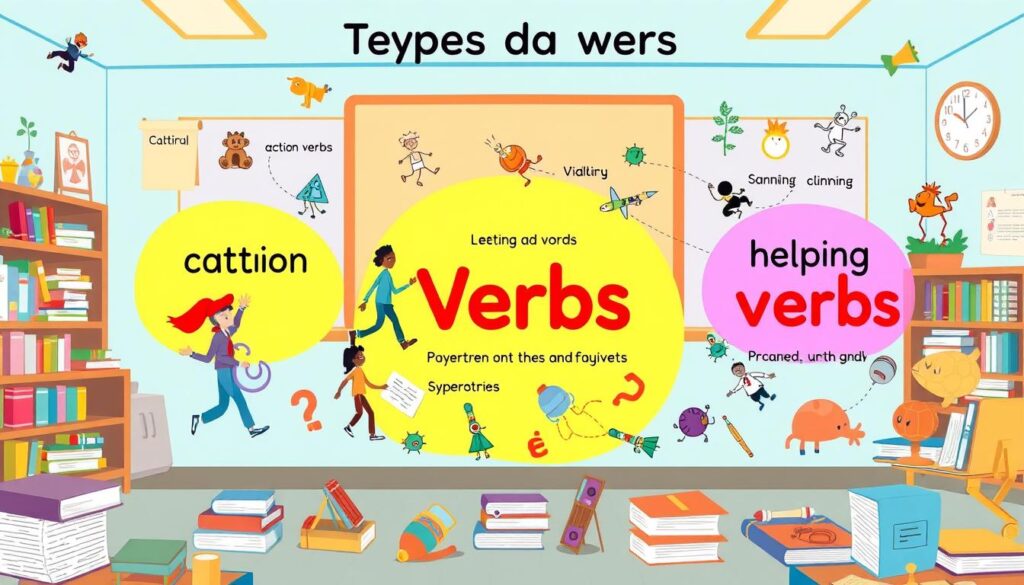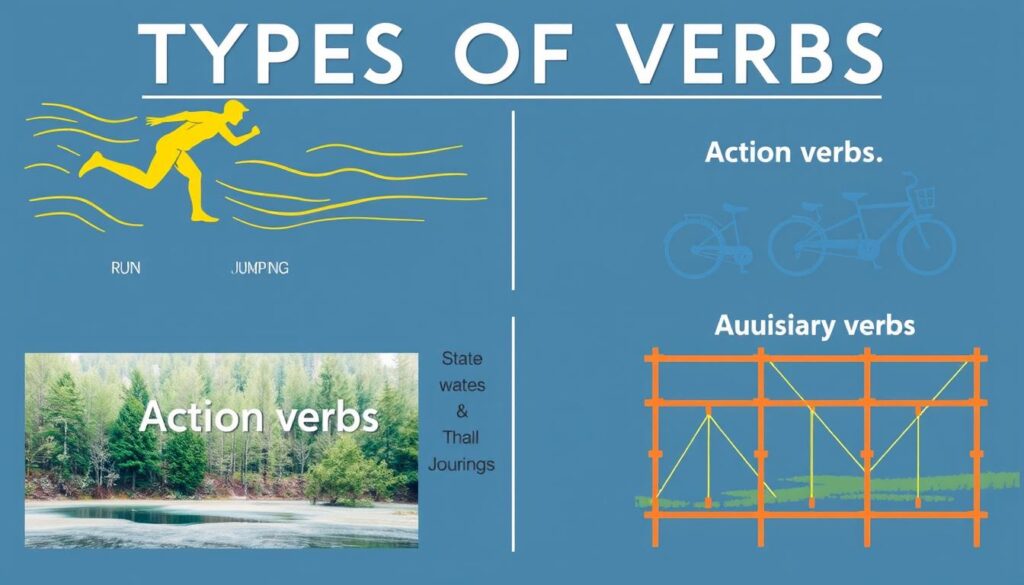Welcome to your journey toward verb mastery! You’ll learn how verbs are key in language. They help us talk about actions and states of being. By learning about different verbs, you’ll get better at writing and speaking.
Get ready to make your language clearer and more coherent. We’ll explore essential verb definitions. This will help you understand this important concept better.

Key Takeaways
- Verbs serve as a core element in constructing sentences.
- Understanding types of verbs enhances your grammatical skills.
- Mastering verbs leads to improved communication effectiveness.
- Verbs encompass actions, occurrences, and states of being.
- Solid verb definitions foster clarity in both written and spoken language.
- Recognizing verb types is essential for effective language use.
Understanding Verbs: The Backbone of Language
Verbs are key in any language. They show actions or states in a sentence, making things clear. Knowing what verbs are helps us understand how they help us talk and write.
Verbs can be action words like “run” or state words like “is.” They are the heart of our language.
What are Verbs?
Verbs show actions or conditions in many ways. They are divided into groups for different uses. Action verbs like “jump” or “write” show what we do. Stative verbs like “know” or “see” show what we feel or see.
Knowing these types helps us use verbs better.
Importance of Verbs in Grammar
Verbs are key in grammar for many reasons. They show actions and connect subjects and predicates. This helps us make clear sentences that share our ideas well.
Good communication depends on using verbs right. So, learning about verbs is important for clear talking.
How Verbs Function in Sentences
This part talks about verbs in sentences. They change the meaning and clarity of sentences. Verbs work in different ways in sentences like questions, commands, and statements.
By looking at how verbs work, we see how they help us talk and share ideas. Here’s a table showing how verbs work in different sentences:
| Sentence Type | Example | Verb Function |
|---|---|---|
| Statement | I am reading. | Declares action. |
| Question | Are you coming? | Inquires about action. |
| Command | Close the door. | Directs action. |
What is types of verbs?
Learning about types of verbs is key to getting better at grammar. This part explains the different kinds of verbs. It gives you clear verb definitions to help you tell them apart.
Defining Different Types of Verbs
Verbs fall into several groups, each with its own job in talking and writing. Let’s look at some common types:
- Action Verbs: These verbs show physical or mental actions. Examples are “run,” “jump,” and “think.”
- Linking Verbs: These verbs link the subject of a sentence to more info. Common ones are “am,” “is,” and “were.”
- Auxiliary Verbs: Also called helping verbs, they help the main verb show tense, mood, or voice. Examples include “have,” “will,” and “can.”
Action Verbs vs. State of Being Verbs
Verbs can be divided into action verbs and state of being verbs. Action verbs show what’s happening, while state of being verbs tell us about existence or condition. Let’s dive deeper:
| Type of Verb | Definition | Examples |
|---|---|---|
| Action Verbs | Denote physical or mental activities. | run, eat, think |
| State of Being Verbs | Describe existence or condition. | am, is, are |
Understanding these differences helps you grasp verb definitions better. Each type is important for making sentences that mean something.

Conclusion
We’ve looked into verbs and their types, which are key to our language. This article wraps up our exploration of verbs. It shows how important they are for clear communication.
Verbs are essential for making sentences clear and lively. They help us express our thoughts well. By learning about verbs, you can share your ideas more effectively.
Now, try using verbs in your daily talks and writing. Getting better at verbs will make your language skills stronger. This will help you communicate more clearly and confidently.
FAQ
What are the different types of verbs?
Verbs come in three main types: action verbs, linking verbs, and auxiliary verbs. Action verbs show actions happening. Linking verbs connect the subject to more info. Auxiliary verbs help with tense and mood.
Why is understanding verb usage important?
Knowing how to use verbs is key for better grammar and communication. It helps you share your ideas clearly. This makes your writing more understandable.
How do verbs function within sentences?
Verbs link subjects and predicates, showing actions or states. For instance, in “She runs quickly,” “runs” is the verb. It tells us what she is doing.
Can you provide examples of action verbs and state of being verbs?
Sure! Action verbs like “run,” “jump,” and “think” show physical or mental actions. State of being verbs, like “am,” “is,” and “are,” describe conditions or existence.
What role do verbs play in sentence structure?
Verbs are key in sentence structure. They show the main action or state, linking ideas. This makes sentences clear and effective.
How can I improve my understanding of grammar fundamentals related to verbs?
To get better at verb grammar, practice spotting different verbs in sentences. Study their roles and do exercises on verb tenses and agreements. This will boost your writing skills.




